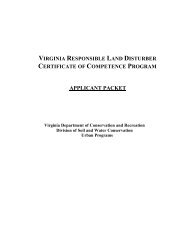Appendix 4-A - Virginia Department of Conservation and Recreation ...
Appendix 4-A - Virginia Department of Conservation and Recreation ...
Appendix 4-A - Virginia Department of Conservation and Recreation ...
Create successful ePaper yourself
Turn your PDF publications into a flip-book with our unique Google optimized e-Paper software.
Typical Costs for Trail & Path Construction<br />
Trail <strong>and</strong> path construction costs vary greatly by location, complexity <strong>of</strong> design,<br />
surface material, choice <strong>of</strong> installer, <strong>and</strong> other factors <strong>and</strong> thus are typically<br />
presented as estimates rather than specific amounts. The estimates on the<br />
following pages were developed using average costs compiled from historical<br />
precedent, bid tabulations from current projects, VDOT bid tabulations, <strong>and</strong> other<br />
sources. The best source, however, <strong>of</strong>ten is the manufacturer or supplier who<br />
can provide up-to-the-minute costs over the telephone or via e-mail. In these<br />
instances, be sure to add in costs for shipping <strong>and</strong> installation since many<br />
manufacturers <strong>and</strong> suppliers only give costs for materials alone. Costs should be<br />
adjusted in subsequent years to adjust for varying economic conditions,<br />
fluctuations in material costs, <strong>and</strong> other variables.<br />
Each dollar amount in the “Estimated Cost” column on the following spreadsheet<br />
represents a single cost for labor, materials, overhead <strong>and</strong> pr<strong>of</strong>it, <strong>and</strong> installation<br />
in 2011 dollars. The “Unit” column refers to the unit <strong>of</strong> measure typically applied<br />
to each item. For example, on-site earthwork is generally costed at $5.00 per<br />
cubic yard <strong>and</strong> therefore one needs to know how many cubic yards are required<br />
for each project.<br />
Always remember to add a line item for contingencies in your cost estimate to<br />
account for unexpected work. A typical contingency amount is 10% to 12% <strong>of</strong> the<br />
subtotaled construction cost. Design <strong>and</strong> consultant fees must also be accounted<br />
for <strong>and</strong> also typically range between 10% <strong>and</strong> 12% <strong>of</strong> the subtotaled construction<br />
cost.<br />
Cost Estimation Resources:<br />
Flink, Charles A., Kristine Olka, <strong>and</strong> Robert M. Searns. Trails for the Twenty-First<br />
Century: Planning, Design, <strong>and</strong> Management Manual for Multi-Use Trails.<br />
Washington: Isl<strong>and</strong> Press, 2001.<br />
R.S. Means/Reed Construction Data Site Work & L<strong>and</strong>scape Cost Data.<br />
Available at:<br />
http://rsmeans.reedconstructiondata.com/<br />
<strong>Virginia</strong> <strong>Department</strong> <strong>of</strong> Transportation Bid Tabulations<br />
(Tabulation costs include overhead, pr<strong>of</strong>it, <strong>and</strong> labor costs)<br />
http://www.virginiadot.org/business/const/resources-bidtabs.asp
















